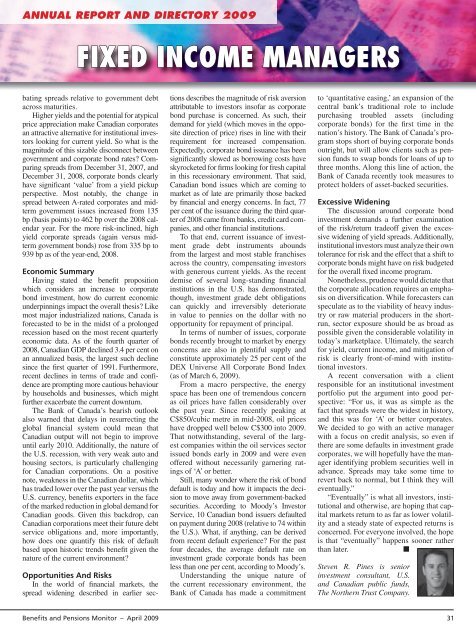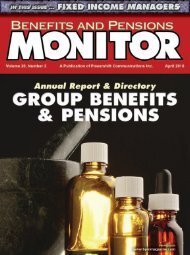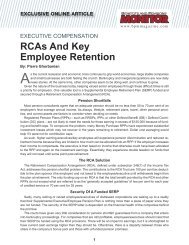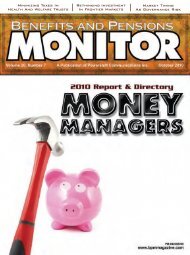April - Benefits and Pensions Monitor
April - Benefits and Pensions Monitor
April - Benefits and Pensions Monitor
You also want an ePaper? Increase the reach of your titles
YUMPU automatically turns print PDFs into web optimized ePapers that Google loves.
ANNUAL REPORT AND DIRECTORY 2009<br />
FIXED INCOME MANAGERS<br />
bating spreads relative to government debt<br />
across maturities.<br />
Higher yields <strong>and</strong> the potential for atypical<br />
price appreciation make Canadian corporates<br />
an attractive alternative for institutional investors<br />
looking for current yield. So what is the<br />
magnitude of this sizable disconnect between<br />
government <strong>and</strong> corporate bond rates? Comparing<br />
spreads from December 31, 2007, <strong>and</strong><br />
December 31, 2008, corporate bonds clearly<br />
have significant ‘value’ from a yield pickup<br />
perspective. Most notably, the change in<br />
spread between A-rated corporates <strong>and</strong> midterm<br />
government issues increased from 135<br />
bp (basis points) to 462 bp over the 2008 calendar<br />
year. For the more risk-inclined, high<br />
yield corporate spreads (again versus midterm<br />
government bonds) rose from 335 bp to<br />
939 bp as of the year-end, 2008.<br />
Economic Summary<br />
Having stated the benefit proposition<br />
which considers an increase to corporate<br />
bond investment, how do current economic<br />
underpinnings impact the overall thesis? Like<br />
most major industrialized nations, Canada is<br />
forecasted to be in the midst of a prolonged<br />
recession based on the most recent quarterly<br />
economic data. As of the fourth quarter of<br />
2008, Canadian GDP declined 3.4 per cent on<br />
an annualized basis, the largest such decline<br />
since the first quarter of 1991. Furthermore,<br />
recent declines in terms of trade <strong>and</strong> confidence<br />
are prompting more cautious behaviour<br />
by households <strong>and</strong> businesses, which might<br />
further exacerbate the current downturn.<br />
The Bank of Canada’s bearish outlook<br />
also warned that delays in resurrecting the<br />
global financial system could mean that<br />
Canadian output will not begin to improve<br />
until early 2010. Additionally, the nature of<br />
the U.S. recession, with very weak auto <strong>and</strong><br />
housing sectors, is particularly challenging<br />
for Canadian corporations. On a positive<br />
note, weakness in the Canadian dollar, which<br />
has traded lower over the past year versus the<br />
U.S. currency, benefits exporters in the face<br />
of the marked reduction in global dem<strong>and</strong> for<br />
Canadian goods. Given this backdrop, can<br />
Canadian corporations meet their future debt<br />
service obligations <strong>and</strong>, more importantly,<br />
how does one quantify this risk of default<br />
based upon historic trends benefit given the<br />
nature of the current environment?<br />
Opportunities And Risks<br />
In the world of financial markets, the<br />
spread widening described in earlier sections<br />
describes the magnitude of risk aversion<br />
attributable to investors insofar as corporate<br />
bond purchase is concerned. As such, their<br />
dem<strong>and</strong> for yield (which moves in the opposite<br />
direction of price) rises in line with their<br />
requirement for increased compensation.<br />
Expectedly, corporate bond issuance has been<br />
significantly slowed as borrowing costs have<br />
skyrocketed for firms looking for fresh capital<br />
in this recessionary environment. That said,<br />
Canadian bond issues which are coming to<br />
market as of late are primarily those backed<br />
by financial <strong>and</strong> energy concerns. In fact, 77<br />
per cent of the issuance during the third quarter<br />
of 2008 came from banks, credit card companies,<br />
<strong>and</strong> other financial institutions.<br />
To that end, current issuance of investment<br />
grade debt instruments abounds<br />
from the largest <strong>and</strong> most stable franchises<br />
across the country, compensating investors<br />
with generous current yields. As the recent<br />
demise of several long-st<strong>and</strong>ing financial<br />
institutions in the U.S. has demonstrated,<br />
though, investment grade debt obligations<br />
can quickly <strong>and</strong> irreversibly deteriorate<br />
in value to pennies on the dollar with no<br />
opportunity for repayment of principal.<br />
In terms of number of issues, corporate<br />
bonds recently brought to market by energy<br />
concerns are also in plentiful supply <strong>and</strong><br />
constitute approximately 25 per cent of the<br />
DEX Universe All Corporate Bond Index<br />
(as of March 6, 2009).<br />
From a macro perspective, the energy<br />
space has been one of tremendous concern<br />
as oil prices have fallen considerably over<br />
the past year. Since recently peaking at<br />
C$850/cubic metre in mid-2008, oil prices<br />
have dropped well below C$300 into 2009.<br />
That notwithst<strong>and</strong>ing, several of the largest<br />
companies within the oil services sector<br />
issued bonds early in 2009 <strong>and</strong> were even<br />
offered without necessarily garnering ratings<br />
of ‘A’ or better.<br />
Still, many wonder where the risk of bond<br />
default is today <strong>and</strong> how it impacts the decision<br />
to move away from government-backed<br />
securities. According to Moody’s Investor<br />
Service, 10 Canadian bond issuers defaulted<br />
on payment during 2008 (relative to 74 within<br />
the U.S.). What, if anything, can be derived<br />
from recent default experience? For the past<br />
four decades, the average default rate on<br />
investment grade corporate bonds has been<br />
less than one per cent, according to Moody’s.<br />
Underst<strong>and</strong>ing the unique nature of<br />
the current recessionary environment, the<br />
Bank of Canada has made a commitment<br />
to ‘quantitative easing,’ an expansion of the<br />
central bank’s traditional role to include<br />
purchasing troubled assets (including<br />
corporate bonds) for the first time in the<br />
nation’s history. The Bank of Canada’s program<br />
stops short of buying corporate bonds<br />
outright, but will allow clients such as pension<br />
funds to swap bonds for loans of up to<br />
three months. Along this line of action, the<br />
Bank of Canada recently took measures to<br />
protect holders of asset-backed securities.<br />
Excessive Widening<br />
The discussion around corporate bond<br />
investment dem<strong>and</strong>s a further examination<br />
of the risk/return tradeoff given the excessive<br />
widening of yield spreads. Additionally,<br />
institutional investors must analyze their own<br />
tolerance for risk <strong>and</strong> the effect that a shift to<br />
corporate bonds might have on risk budgeted<br />
for the overall fixed income program.<br />
Nonetheless, prudence would dictate that<br />
the corporate allocation requires an emphasis<br />
on diversification. While forecasters can<br />
speculate as to the viability of heavy industry<br />
or raw material producers in the shortrun,<br />
sector exposure should be as broad as<br />
possible given the considerable volatility in<br />
today’s marketplace. Ultimately, the search<br />
for yield, current income, <strong>and</strong> mitigation of<br />
risk is clearly front-of-mind with institutional<br />
investors.<br />
A recent conversation with a client<br />
responsible for an institutional investment<br />
portfolio put the argument into good perspective:<br />
“For us, it was as simple as the<br />
fact that spreads were the widest in history,<br />
<strong>and</strong> this was for ‘A’ or better corporates.<br />
We decided to go with an active manager<br />
with a focus on credit analysis, so even if<br />
there are some defaults in investment grade<br />
corporates, we will hopefully have the manager<br />
identifying problem securities well in<br />
advance. Spreads may take some time to<br />
revert back to normal, but I think they will<br />
eventually.”<br />
“Eventually” is what all investors, institutional<br />
<strong>and</strong> otherwise, are hoping that capital<br />
markets return to as far as lower volatility<br />
<strong>and</strong> a steady state of expected returns is<br />
concerned. For everyone involved, the hope<br />
is that “eventually” happens sooner rather<br />
than later.<br />
■<br />
Steven R. Pines is senior<br />
investment consultant, U.S.<br />
<strong>and</strong> Canadian public funds,<br />
The Northern Trust Company.<br />
<strong>Benefits</strong> <strong>and</strong> <strong>Pensions</strong> <strong>Monitor</strong> – <strong>April</strong> 2009<br />
31









